Siem Reap – day 2
Travels throughout Europe are often remembered through the lens of what cathedral or castle you visited. Most are magnificent. But, there comes a time when even the heartiest of tourist are effected by the ABC syndrome; ABC….’Another Bloody Cathedral/Castle’. When the ABC’s hit, it’s time to do something else….anything else, but see another Castle. But, as this is the Cambodia Angkor Park Blog, is there a Cambodian Companion to this sentiment?
In Siem Reap there must be the complimentary syndrome ‘ABW’ – Anther Bloody Wat. Fortunately, I haven’t been stricken by it’s effects yet. But, I expect by the end of tomorrow’s tuk-tuck adventure to a few of the more out-of-the-way Wats, the syndrome will weaken my nerve. This works out well as I’m beginning to work my way back to the the cold and dark of Alaska the following day. I’ll not have seen everything, but I’m fine with that, it’s always a hopeful perspective to leave a few desires unquenched, giving one the need to return another day and perhaps another
Angkor by Sunrise

Every guide book recommends seeing Angkor Wat at sunrise….so I did. It wasn’t spectacular, but, it was a good way to get a long day started early, very early. It’s not that I’m cheap, I am, but I wanted the freedom of maneuver to visit exactly where I wanted, when I wanted, without a ‘chaperone’ or the burdens of another’s needs subjected to my whims. So, rather than hire the ubiquitous and inexpensive tuk-tuk, I rented a bike and headed out with headlamp at 0430.
I’d been advised that it would take me an hour, but in 30 minutes I had cleared the park checkpoints (where my headlamp promptly failed me) and found myself in the dark, looking for the perfect spot to observe the sunrise, just like 400 other tourist. The guidebooks recommend a spot on the North Eastern corner of the northern pond in front of the Wat as it provides the best reflections off the lake. So, I found one. Wise guides suggest getting there early enough so you can sit with your feet next to the water. This way no-one can sneak in front of you at the last minute and foul your photos. This, advice turned out to be ‘spot-on’ and I’m glad I followed it, as did hundreds others.
Beautiful, but unfortunately not Spectacular
By 0510 I was sitting on a rock, with my feet flat on another large rock overhanging the pond. To either side, shoulder to shoulder, sat other tourists who must have read the same guidebooks. By 0530, I turned around and the crowd had thickly grown behind me. By 0545, there was nothing but a wall of humanity, you’d could not see beyond the people to my back. I was happy to have had the perfect spot to view the quintessential and sublime morning sunrise. Regrettably, it was a cloudy morning and the sky grew from black, to gray to a much lighter gray. No National Geographic spectacular photos were taken that morning. Still, it was a cool thing to do.
and the Wat touring begins
After sunrise, rather than explore the Angkor Wat ruins, I wrangled my way past the throngs of tourist heading into the Wat so I could hop on the bike and beat the crowds to the next one. The plan was to spend quality time at Angkor the next day, so it was time to go. Angkor Park is commonly referred to as Angkor Wat. But Angkor Wat is just one of the numerous sites to be seen in the park. It’s one of the most well preserved, and therefore the most spectacular; but many others rank highly in ‘must see’ World Heritage sites.

The next site up the road is Angkor Thom, formerly the Khmer Capitol. It’s several wats and sites are bounded by another moat and high walls. Perhaps the most memorable, and well know of the Thom’s sites, is Bayon. It’s most recognized by the many four faced towers. The site is overwhelming in it’s complexity. Engineers back in King Jayavarman-VII’s day (the reigning king who built Angkor Thom) must have been overworked. Also spread within the walls of Thom are numerous pyramid type Wats and other structures that one could spend days of viewing all on their own. Suffice it to say, Angkor Thom must have been a splendid place of regal wealth and strength in its day.
16 Wats in one day
Below is a list of 16 Wats and sights I visited on the first day. The combind journey was 39 miles of walking and riding (according to my bike ap). It was happy decision to bike rather than hire a tuk-tuk, even when the unseasonable downpour of rain caught me on my last 4 miles. I was happier to have made it back to a shower, AC and a cold beer while pleasantly reliving the exhausting and magical day of finally doing the ‘Wat thing’.
Special Mentions
Of the sixteen sites, there are two more worth calling out with special attention. All the sights are magnificent (this will be an overused, but appropriate, word) but these two are just more memorable. Preah Khan, just north of Angkor Thom is another very well known Wat, often seen in movies where the ancient jungles hide away ancient wisdom. It too is a very large and complex series of structures with many byzantine like hallways, jutting towers and multi leveled courtyards. The next is Ta Prohm, know for its curious spectacles of gigantic trees sprouting out of it’s ruins. To this day it’s still very much in its ‘found’ condition and a very popular site among tourist. All of the sights I viewed that day were ‘magnificent’ and splendorous and they whisk one’s thoughts back to another era, almost another world of enigmatic ways and mysterious peoples.
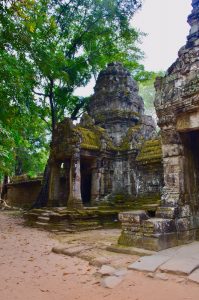
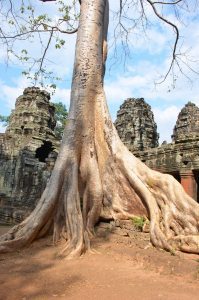
A day in Angkor Wat
The following day’s efforts focused purely on Angkor Wat. Even after seeing 16 sites the previous day, this one sight was overwhelming by itself. It’s the most well preserved of those that I visited thus far; it’s an amazing structure. The history books and encyclopedias can all describe how it’s shaped to represent a version of the Hindu world with lakes and mountains.
Again, the talented engineers must worked miracles of ingenuity just in developing it’s architectural drawings (however they did it back then). The actual construction in itself is monumental.
What I found most interesting are the bas-reliefs. One often sees pictures of Angkor and is amazed by it’s magnitude and numbers of towers and long hallways and courtyards. But what we don’t see in those photos is that all the walls are covered in bas-reliefs depicting scenes from Hindu lore (and Buddhist) and the stories of the king’s conquering adventures. They are everywhere along the hallways, the ceilings, the floors and even snake their way up the walls of the towers. These days, much has eroded away, but they’re presence is still obvious.
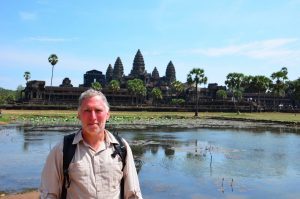
The wat is a literal storyboard of history and religion. I walked through in wat in three hours, but without the noisy and intrusive crowds around every nook and cranny, it could easily taken two days.
Enjoy a short VLog on my visits to the Wats
Bas Reliefs around Angkor Wat
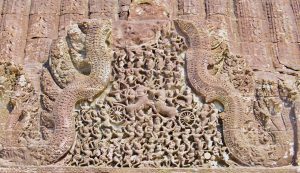
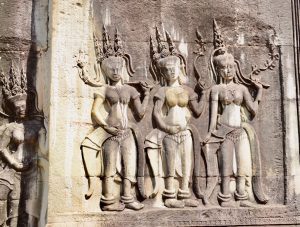

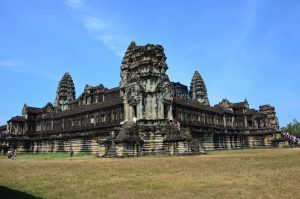
Seim Reap
Tomorrow, I’m touring the town of Seim Reap followed by a day out to a few more of the out-of-the-way wats, and then I think I’m done. ABW will have arrived just in time.
the markets
Over the past week I’ve visited numerous ‘Markets’. A few have been the typical tourist venue selling cheap tourist crap and the inexpensive ‘seconds’ that never made it to their intended overseas stores. However, a few of the markets I wandered through were the traditional, or ‘local’ variety not set up for tourist intrusions. Only one word comes to mind when visiting these markets – “medieval”.
I suspect these types of bazaars have not changed in a thousand years. The ’emporiums’ are more than just shopping centers, they are homes away from home, shops and social life all rolled into one. It’s not atypical to see hammocks hung up in stalls with shopkeepers and children sleeping idly away while life teams around them. Most are covered with tin-roofs or tarpaulins to protect the stalls and wares from the burning sun and the deluging monsoons. Due to any perceived lack of health and safety standards, products are stacked to the ceilings and cover every usable inch of ground not taken for bartering.
The lights are dim, the colors are bright and the smells and odors can be over-powering. The markets have a sub-terrainian, grotto-like feel to them that spelunkers would appreciate. Shoppers buy shoes next to couples slurping away their lunch soup. The gold sellers hawk their finery as the plastic merchant with buckets and spoons look warmly on.
Butcher Stalls
The wares, in some cases, may be more modern but clearly in the produce and meat departments, nothing has changed in eons. Vegetables and fruits are still splayed out across wooden boards, stacked high in all their goodness. But it’s in the meat stands that one with a less solid stomach could easily be repulsed. The common site is of the young lady with the big, thick round chopping block and the bigger cleaver, hacking away at some barely recognizable portion of animal. Bits and pieces of meat and bone flick here and there. Skinny dogs loiter in the background waiting for a cast-off sliver to make it far enough for them to scoop up without getting kicked.
The chopping block’s casualties are all staged on bloody boards, speckled with flies and dust. Pigs heads are the most recognizable, cow tongues seem to be popular and the plucked chickens are a sight one could easily find in a modern horror movie. I suspect this is the way humans have always sold food and we antiseptic westerners, with our packaged and bleached ways, have lost touch with the reality of from where our food comes, and how it’s prepared. I for one, and grateful of that. The smells of those stalls are noxious, simply repulsive. But, it is life in it’s pure simplicity.
Enjoy a short vid on a few of the scenes of Siem Reap.
List of visited Wats
Wats and sights within the Angkor Park visited thus far. Descriptions are courtesy of Wikipedia
38.29 Miles bike riding and walking, over 9 and half hours to visit 17 sites, 25 Jan 18
Angkor Wat for the sunrise
Baksei Chamkrong
(Khmer: ប្រាសាទបក្សីចាំក្រុង) is a small Hindu temple located in the Angkor complex (Siem Reap, Cambodia). It is dedicated to Lord Shiva and used to hold a golden image of him. The temple can be seen on the left side when entering Angkor Thom at the southern gate. It was dedicated to Yasovarman by his son, King Harshavarman I. The temple was completed by Rajendravarman II (944-968)
South Gate, Angkor Thom
The Bayon
(Khmer: ប្រាសាទបាយ័ន, Prasat Bayon) is a well-known and richly decorated Khmer temple at Angkor in Cambodia. Built in the late 12th or early 13th century as the official state temple of the Mahayana Buddhist King Jayavarman VII (Khmer: ព្រះបាទជ័យវរ្ម័នទី ៧), the Bayon stands at the centre of Jayavarman’s capital, Angkor Thom (Khmer: អង្គរធំ). Following Jayavarman’s death, it was modified and augmented by later Hindu and Theravada Buddhist kings in accordance with their own religious preferences.
The Baphuon
(Khmer: ប្រាសាទបាពួន) is a temple at Angkor, Cambodia. It is located in Angkor Thom, northwest of the Bayon. Built in the mid-11th century, it is a three-tiered temple mountain built as the state temple of Udayadityavarman dedicated to the Hindu God Shiva. It is the archetype of the Baphuon style with intricate carvings covering every available surface. The temple adjoins the southern enclosure of the royal palace and measures 120 metres east-west by 100 metres north-south at its base and stands 34 meters tall without its tower, which would have made it roughly 50 meters tall. Its appearance apparently impressed Temür Khan’s late 13th century envoy Chou Ta-kuan during his visit from 1296 to 1297, who said it was ‘the Tower of Bronze…a truly astonishing spectacle, with more than ten chambers at its base.’
Phimeanakas
(Khmer: ប្រាសាទភិមានអាកាស, Prasat Phimean Akas, ‘celestial temple’) or Vimeanakas (Khmer: ប្រាសាទវិមានអាកាស, Prasat Vimean Akas) at Angkor, Cambodia, is a Hindu temple in the Khleang style, built at the end of the 10th century, during the reign of Rajendravarman (from 941-968), then completed by Suryavarman I in the shape of a three tier pyramid as a Hindu temple. On top of the pyramid there was a tower, while on the edge of top platform there are galleries. Phimeanakas is located inside the walled enclosure of the Royal Palace of Angkor Thom north of Baphuon.
The Terrace of the Elephants
(Khmer: ព្រះលានជល់ដំរី) is part of the walled city of Angkor Thom, a ruined temple complex in Cambodia. The terrace was used by Angkor’s king Jayavarman VII as a platform from which to view his victorious returning army. It was attached to the palace of Phimeanakas (Khmer: ប្រាសាទភិមានអាកាស), of which only a few ruins remain. Most of the original structure was made of organic material and has long since disappeared. Most of what remains are the foundation platforms of the complex. The terrace is named for the carvings of elephants on its eastern face.
The 350m-long Terrace of Elephants was used as a giant reviewing stand for public ceremonies and served as a base for the king’s grand audience hall. It has five outworks extending towards the Central Square-three in the centre and one at each end. The middle section of the retaining wall is decorated with life size garuda and lions; towards either end are the two parts of the famous parade of elephants complete with their Khmer mahouts.
North Gate, Angkor Thom
Preah Khan
(Khmer: ប្រាសាទព្រះខ័ន; “Royal Sword”) is a temple at Angkor, Cambodia, built in the 12th century for King Jayavarman VII to honor his father: It is located northeast of Angkor Thom and just west of the Jayatataka baray, with which it was associated. It was the centre of a substantial organisation, with almost 100,000 officials and servants. The temple is flat in design, with a basic plan of successive rectangular galleries around a Buddhist sanctuary complicated by Hindu satellite temples and numerous later additions. Like the nearby Ta Prohm, Preah Khan has been left largely unrestored, with numerous trees and other vegetation growing among the ruins.
Neak Pean
(or Neak Poan) [2] (Khmer: ប្រាសាទនាគព័ន្ធ) (“The entwined serpents”) at Angkor, Cambodia is an artificial island with a Buddhist temple on a circular island in Jayatataka Baray, which was associated with Preah Khan temple, built during the reign of King Jayavarman VII. It is the “Mebon” of the Preah Khan baray (the “Jayatataka” of the inscription).
Ta Som
(Khmer: ប្រាសាទតាសោម) is a small temple at Angkor, Cambodia, built at the end of the 12th century for King Jayavarman VII. It is located north east of Angkor Thom and just east of Neak Pean. The King dedicated the temple to his father Dharanindravarman II (Paramanishkalapada) who was King of the Khmer Empire from 1150 to 1160. The temple consists of a single shrine located on one level and surrounded by enclosure laterite walls. Like the nearby Preah Khan and Ta Prohm the temple was left largely unrestored, with numerous trees and other vegetation growing among the ruins. In 1998, the World Monuments Fund (WMF) added the temple to their restoration program and began work to stabilise the structure to make it safer for visitors.
The East Mebon
(Khmer: ប្រាសាទមេបុណ្យខាងកើត) is a 10th Century temple at Angkor, Cambodia. Built during the reign of King Rajendravarman, it stands on what was an artificial island at the center of the now dry East Baray reservoir
Pre Rup
(Khmer: ប្រាសាទប្រែរូប) is a Hindu temple at Angkor, Cambodia, built as the state temple of Khmer king Rajendravarman and dedicated in 961 or early 962. It is a temple mountain of combined brick, laterite and sandstone construction.
Srah Srang
(Khmer: ស្រះស្រង់) is a baray or reservoir at Angkor, Cambodia, located south of the East Baray and east of Banteay Kdei.
Bat Chum (Khmer: ប្រាសាទបាទជុំ) is a small temple built by Kavindrarimathana, a learned Buddhist minister of khmer king Rajendravarman, at the middle of the 10th century. It is located about 400 meters south of Srah Srang, at Angkor, Cambodia.
Ta Prohm
(Khmer: ប្រាសាទតាព្រហ្ម, pronunciation: prasat taprohm) is the modern name of the temple at Angkor, Siem Reap Province, Cambodia, built in the Bayon style largely in the late 12th and early 13th centuries and originally called Rajavihara (in Khmer: រាជវិហារ). Located approximately one kilometre east of Angkor Thom and on the southern edge of the East Baray, it was founded by the Khmer King Jayavarman VII as a Mahayana Buddhist monastery and university. Unlike most Angkorian temples, Ta Prohm is in much the same condition in which it was found: the photogenic and atmospheric combination of trees growing out of the ruins and the jungle surroundings have made it one of Angkor’s most popular temples with visitors.
UNESCO inscribed Ta Prohm on the World Heritage List in 1992. Today, it is one of the most visited complexes in Cambodia’s Angkor region. The conservation and restoration of Ta Prohm is a partnership project of the Archaeological Survey of India and the APSARA (Authority for the Protection and Management of Angkor and the Region of Siem Reap)
Banteay Kdei
(Khmer: ប្រាសាទបន្ទាយក្តី; Prasat Banteay Kdei), meaning “A Citadel of Chambers”, also known as “Citadel of Monks’ cells”, is a Buddhist temple in Angkor, Cambodia. It is located southeast of Ta Prohm and east of Angkor Thom. Built in the mid-12th to early 13th centuries AD during the reign of Jayavarman VII (who was posthumously given the title “Maha paramasangata pada”, it is in the Bayon architectural style, similar in plan to Ta Prohm and Preah Khan, but less complex and smaller. Its structures are contained within two successive enclosure walls, and consist of two concentric galleries from which emerge towers, preceded to the east by a cloister.
26 Jan 18
Angkor Wat
(Khmer: អង្គរវត្ត or “Capital Temple”) is a temple complex in Cambodia and the largest religious monument in the world,[1] on a site measuring 162.6 hectares (1,626,000 m2; 402 acres).[2] Originally constructed as a Hindu temple of the god Vishnu for the Khmer Empire, It gradually transfored into a Buddhist temple towards the end of the 12th century.[3]
It was built by the Khmer King Suryavarman II in the early 12th century in Yaśodharapura (Khmer: យសោធរបុរៈ, present-day Angkor), the capital of the Khmer Empire, as his state temple and eventual mausoleum. Breaking from the Shaiva tradition of previous kings, Angkor Wat was instead dedicated to Vishnu. As the best-preserved temple at the site, it is the only one to have remained a significant religious centre since its foundation. The temple is at the top of the high classical style of Khmer architecture. It has become a symbol of Cambodia,[5] appearing on its national flag, and it is the country’s prime attraction for visitors
For a longer VLog of the adventure to Cambodia, enjoy this link
Link here to jump to the first entry of this blog.
Cambodia and Angkor Park Photo Gallery
Angkor Park theme T-shirt designed by the ‘Cottage’? check out this link

Care to comment on the Blog or Adventure? Jot down your comments in the form below – thanks
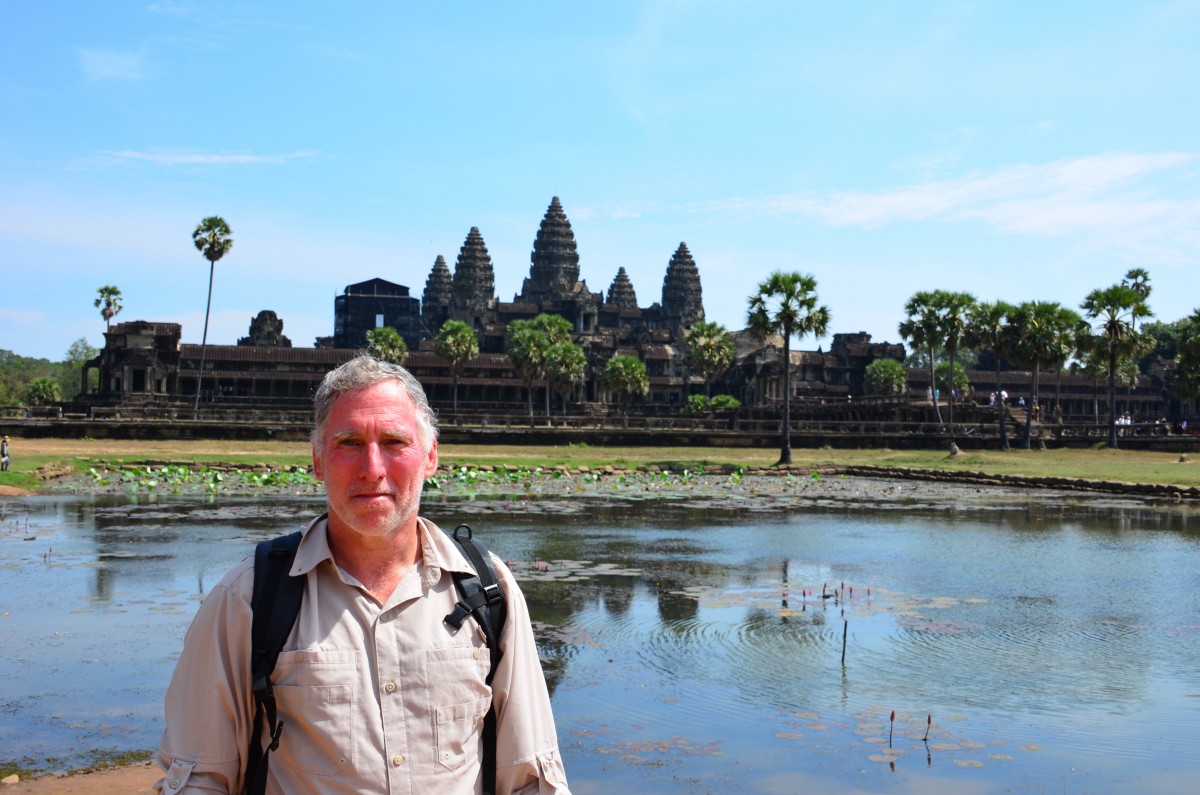
Very good post, keep up the good work. Thanks!
I am impressed with this website , really I am a fan.
Sounds interesting. next time I’ll come with you ! Other than the obvious heat it should be very interesting to visit. Well mein Schatz, have a safe flight home and I’ll talk to you soon